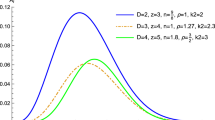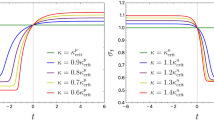Abstract
By starting from a Perelman entropy functional and considering the Ricci–DeTurck flow equations, we analyze the behavior of Einstein–Hilbert and Einstein–Proca theories with Lifshitz geometry as functions of a flow parameter. In the former case, we found one consistent fixed point that represents flat space-time as the flow parameter tends to infinity. Massive vector fields in the latter theory enrich the system under study and have the same fixed point achieved at the same rate as in the former case. The geometric flow is parametrized by the metric coefficients and represents a change in anisotropy of the geometry toward an isotropic flat space-time as the flow parameter evolves. Indeed, the flow of the Proca fields depends on certain coefficients that vanish when the flow parameter increases, rendering these fields constant. We have been able to write down the evolving Lifshitz metric solution with positive, but otherwise arbitrary, critical exponents relevant to geometries with spatially anisotropic holographic duals. We show that both the scalar curvature and matter contributions to the Ricci–DeTurck flow vanish under the flow at a fixed point consistent with flat space-time geometry. Thus, the behavior of the scalar curvature always increases, homogenizing the geometry along the flow. Moreover, the theory under study keeps positive-definite, but decreasing, the entropy functional along the Ricci–DeTurck flow.


Similar content being viewed by others
Data Availability Statement
Data sharing is not applicable to this article as no datasets were generated or analyzed during the current study.
Notes
And in particular, Ricci flows.
Like Massive vector field, supergravity and string theory [21].
See for example [23] for some applications of Ricci flows in General Relativity.
We mentioned in the introduction section that, within the holographic framework, the so-called critical exponents \(z_{i}\) of a Lifshitz geometry are to be related with order parameters in quantum critical points of a dual field theory. So far these order parameters are found to be positive in real field theories. Therefore, we considered the corresponding \(z_{i}>0\). However, some or all of these critical exponents can be negative, leading to a scaling that can be compensated by the dilatation of the corresponding \(x_{i}\) coordinates. Therefore, under the evolution of the Ricci flow parameter \(\lambda\), the metric tends to the same fixed point, independently of the sign of the \(\gamma _{i}\) coefficients.
References
R.S. Hamilton, Three-manifolds with positive Ricci curvature. J. Differ. Geom. 17(2), 255–306 (1982)
M. Headrick, T. Wiseman, Ricci flow and black holes. Class. Quantum Grav. 23, 6683–6708 (2006). hep-th/0606086
J. Samuel, S.R. Chowdhury, Geometric flows and black hole entropy. Class. Quantum Grav. 24, F47–F54 (2007). arXiv:0711.0428
J. Samuel, S.R. Chowdhury, Energy, entropy and the Ricci flow. Class. Quantum Grav. 25, 035012 (2008). arXiv:0711.0430
V. Husain, S.S. Seahra, Ricci flows, wormholes and critical phenomena. Class. Quantum Grav. 25, 222002 (2008). arXiv:0808.0880
R. Cartas-Fuentevilla, A. Herrera-Aguilar, J.A. Olvera-Santamaría, Evolution and metric signature change of maximally symmetric spaces under the Ricci flow. Eur. Phys. J. Plus 133(6), 235 (2018). arXiv:1707.07235
R. Cartas-Fuentevilla, A. Herrera-Aguilar, J.A. Herrera-Mendoza, Constructing Lifshitz spaces using the Ricci flow. Ann. Phys. 415, 168093 (2020). arXiv:1812.06239
G. Perelman, The entropy formula for the Ricci flow and its geometric applications. arXiv Mathematics e-prints (2002). math/0211159
D.M. DeTurck, Deforming metrics in the direction of their Ricci tensors. J. Differ. Geom. 18(1), 157–162 (1983)
J. de Boer, E.P. Verlinde, H.L. Verlinde, On the holographic renormalization group. JHEP 08, 003 (2000). hep-th/9912012
D. Friedan, Nonlinear models in \(2+\epsilon\) dimensions. Phys. Rev. Lett. 45, 1057–1060 (1980)
I. Heemskerk, J. Polchinski, Holographic and Wilsonian renormalization groups. JHEP 06, 031 (2011). arXiv:1010.1264
E.T. Akhmedov, A Remark on the AdS/CFT correspondence and the renormalization group flow. Phys. Lett. B 442, 152–158 (1998). hep-th/9806217
V. Balasubramanian, P. Kraus, Space-time and the holographic renormalization group. Phys. Rev. Lett. 83, 3605–3608 (1999). hep-th/9903190
T. Faulkner, H. Liu, M. Rangamani, Integrating out geometry: holographic Wilsonian RG and the membrane paradigm. JHEP 08, 051 (2011). arXiv:1010.4036
P. Mikula, M.E. Carrington, G. Kunstatter, Nonequilibrium approach to holographic superconductors using gradient flow. Phys. Rev. D 100(4), 046004 (2019). arXiv:1902.08669
S.A. Hartnoll, A. Lucas, S. Sachdev, Holographic quantum matter. arXiv:1612.07324
S. Kachru, X. Liu, M. Mulligan, Gravity duals of Lifshitz-like fixed points. Phys. Rev. D 78, 106005 (2008). arXiv:0808.1725
M. Taylor, Non-relativistic holography. arXiv:0812.0530
R. Cartas-Fuentevilla, A. Herrera-Aguilar, V. Matlalcuatzi-Zamora, U. Noriega, J.M. Romero, Anisotropic Lifshitz holography in Einstein–Proca theory with stable negative mass spectrum. Eur. Phys. J. Plus 135(2), 155 (2020). arXiv:1804.02278
R. Gregory, S.L. Parameswaran, G. Tasinato, I. Zavala, Lifshitz solutions in supergravity and string theory. JHEP 12, 047 (2010). arXiv:1009.3445
H. Braviner, R. Gregory, S.F. Ross, Flows involving Lifshitz solutions. Class. Quantum Grav. 28, 225028 (2011). arXiv:1108.3067
E. Woolgar, Some applications of Ricci flow in physics. Can. J. Phys. 86, 645–651 (2008). arXiv:0708.2144
Acknowledgements
All authors have been benefited from the CONACYT Grant No. A1-S-38041, while RCF and AHA were supported by the VIEP-BUAP Grants Nos. 113 and 122. MCL thanks the financial assistance provided by a CONACYT postdoctoral Grant No. 30563. JAHM acknowledges support from CONACYT through a PhD Grant No. 750974. DFHB is also grateful to CONACYT for a Postdoc por México Grant No. 372516.
Author information
Authors and Affiliations
Corresponding author
Rights and permissions
Springer Nature or its licensor (e.g. a society or other partner) holds exclusive rights to this article under a publishing agreement with the author(s) or other rightsholder(s); author self-archiving of the accepted manuscript version of this article is solely governed by the terms of such publishing agreement and applicable law.
About this article
Cite this article
Cartas-Fuentevilla, R., de la Cruz, M., Herrera-Aguilar, A. et al. Evolution of Lifshitz metric anisotropies in Einstein–Proca theory under the Ricci–DeTurck flow. Eur. Phys. J. Plus 137, 1379 (2022). https://doi.org/10.1140/epjp/s13360-022-03606-6
Received:
Accepted:
Published:
DOI: https://doi.org/10.1140/epjp/s13360-022-03606-6




